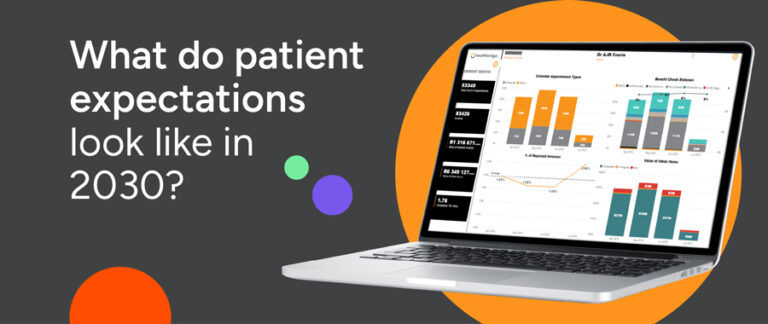
Patient expectations in 2030: What the next five years mean for private practices
In just five years, the patients walking through your door will expect something very different from the experience you may be offering today. Their expectations are being shaped by technology, access to data, personalisation trends, and the seamless experiences they already enjoy in other sectors.
By 2030, private practice patients won’t just want care when they’re sick. They’ll expect proactive, connected, and personalised healthcare that fits into their lives. That means less waiting, more control, seamless digital experiences, and a high standard of service every step of the way.
This isn’t just a tech trend. It’s a strategic shift that will define how competitive, efficient, and patient-focused your practice can be. Here’s what to expect, and how to prepare.
Convenience will be non-negotiable
By 2030, patients will expect the same speed and ease from healthcare that they get from banking, shopping, and travel. That means:
- AI-powered scheduling that offers same-day or next-day appointments
- Digital booking platforms accessible 24/7
- Virtual consultations for common or follow-up concerns
- Real-time updates on waiting times, scripts, and test results
Practices that still rely on phone bookings or paper files will quickly fall behind. Patients won’t wait for outdated systems to catch up.
Action tip: If your scheduling still happens manually, it may be time to explore online booking platforms with integrated reminders, eligibility checks, and payment options.
Care will feel deeply personal
Thanks to data from wearables, apps, and integrated medical records, patients in 2030 will expect care that reflects their full health story, not only what they tell you on the day.
With help from AI, practices will be able to:
- Tailor treatment plans based on lifestyle, history & preferences
- Make informed recommendations using trends in patient data
- Offer preventive care before problems arise
Bear in mind that personalisation doesn’t mean automation alone. The human element will still matter hugely. Patients want to feel seen, heard, and involved in their care.
Action tip: Use tools that make it easier to bring up relevant history, identify risks early, and engage patients with actionable insights.
Patients will want more control
The days of one-way healthcare communication are fading. In future, patients will:
- Expect access to their records at any time
- Want to co-create treatment plans with their provider
- Use apps and devices to track progress, manage conditions, and stay in touch
This shift can feel intimidating to some clinicians, but it’s actually a powerful opportunity. Empowered patients are often more engaged, compliant with treatment plans, and loyal.
Action tip: Enable patient portals or virtual consultations to make it easier for them to access test results, ask follow-up questions, and get guidance without always needing another in-person appointment.
The shift from reactive to proactive care
Technology will increasingly enable practices to spot warning signs early, before patients present with symptoms. In future, successful practices will:
- Use AI to identify risk patterns and flag patients for follow-up
- Offer wellness and chronic care check-ins via virtual consultations
- Monitor patients at home using connected devices
This proactive model could transform how often patients need in-person care, but it won’t reduce their expectations of access, responsiveness, and continuity.
Action tip: Think about how you can build proactive touchpoints into your workflow using digital tools, alerts, and patient engagement systems.
Integration will set the standard
Patients are tired of repeating themselves. They want healthcare to feel coordinated, not fragmented. By 2030, they’ll expect:
- A unified health record shared (securely) across providers
- Seamless referrals, test ordering, and results follow-up
- Fewer forms and less duplication
Practices that rely on generic or disconnected tools will struggle to keep up with this expectation. Integration goes beyond efficiency to be key to the patient experience.
Action tip: Choose healthcare-specific platforms that link billing, clinical notes, prescriptions & reporting in one place.
Technology should enhance, not replace, care
Even as AI, telehealth, and virtual tools become more common, the clinician-patient relationship will still matter most. The role of technology is to:
- Save time, so you can focus more on the conversation
- Reduce admin burden, so you can listen more carefully
- Help standardise records, so you can treat more safely
Empathy, clarity, and personal connection become even more valuable as the present and future become more digital.
Action tip: Choose tools that are easy to use in consult, not ones that distract or distance you from your patient.
The future isn’t far off
2030 is just five years away. The practices that thrive will be those that plan for change, test new systems, and stay close to what their patients want.
This doesn’t mean overhauling everything overnight. It means making smart, incremental improvements that set you up to deliver efficient, connected, human-centred care.
Healthbridge supports over 7,000 South African practices with the tools, insights & support they need to succeed in a rapidly changing healthcare landscape.
Contact Healthbridge to book a free practice health assessment with one of our experienced Business Consultants. Let’s make sure your practice is ready for what comes next.
